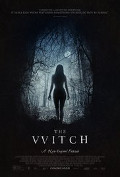
Directed by
Robert Eggers
95 minutes
Rated M
Reviewed by
Sharon Hurst

The Witch
Synopsis: The year is 1630. A family of Christians, ousted from their New England Puritan community because they are too rigid in their religion, eke out an existence on the edge of a forbidding forest. William (Ralph Ineson) and Katherine (Kate Dickie) have five children. When elder daughter Thomasin (Anya Taylor Joy) is minding baby Samuel, he suddenly and mysteriously disappears. Younger brother Caleb (Harvey Scrimshaw) takes it upon himself to search in the forest, but terrible and inexplicable events ensue. As more ill fortune befalls the family, they begin to turn upon each other with accusations of witchcraft.
Robert Eggers is a first time writer-director, and definitely a talent to watch. He grew up in New England, the setting for Edgar Allan Poe’s and Nathaniel Hawthorne’s classic tales, and has incorporated stories of witches and the supernatural, along with his personal nightmares, into his film. I’m not normally a fan of the horror genre but The Witch is more about imagined fear, Eggers freely admitting that he is a fan of some of the great masters of bleakness like film-makers F. W. Murnau and Ingmar Bergman, and artists like Durer and Goya. All these influences have led Eggers to make a film that is truly atmospheric and frightening – in look, setting and plot.
Although a colour film, the palette, employing shades of browns and greys, is closer to black and white. This emphasises the harshness of life, adds to the eeriness and also the oppressiveness of the woods. All aspects of the production design are impeccable, with little makeup employed on the cast – more layers of grime, and a general feeling for the deprivations of farming life in those harch days. Old-fashioned lenses were used for the shooting, creating a remarkable antique effect, along with an unusual aspect ratio that produces an intimidating height for exteriors and a claustrophobic effect for interiors.
Adding even more to the power of the film is the cleverly-constructed plot which blends the physical possibility of real witches with the power of the mind to conjure up demons. Religious fanaticism in the family is so extreme that it readily breeds hysteria whilst what are possibly hallucinations flourish in their over-wrought imaginations as all fall prey to the suspected powers of darkness. The young twins, Mercy (Ellie Grainger) and Jonas (Lucas Dawson), chant nursery rhymes casting the family goat, Black Philip, as an agent of the horned one, and the ever-present uncertainty of what is real and what is not heightens the nail-biting tension. Caleb, who is approaching puberty, is guiltily aware of his older sister’s charms, and after his forest encounter with evil returns ill and almost mad. Whether it is Thomasin’s progression to womanhood via menstruation, or Caleb’s natural youthful desires, both are seen by the adults as demonic manifestations (the film is set a half a century before the real Salem witch hunts, that grim moment in American history in which religion-inspired mass hysteria erupted). The fearfulness is wonderfully augmented by Mark Korven’s score, which employs some truly unique instruments from the 1600s such as primitive fiddles and the traditional Swedish harp, the nyckelharpa.
The choice of going with unknown actors is a smart one as it reinforces the feeling of authenticity. It is doubly effective in that the cast all carry their roles superbly. Whilst the film for most of its economical run time keeps up a gripping level of tension, my one reservation is where it takes the ending. This shouldn’t detract however from a truly frightening but uncommonly fine horror experience.

Want more about this film?


Want something different?




